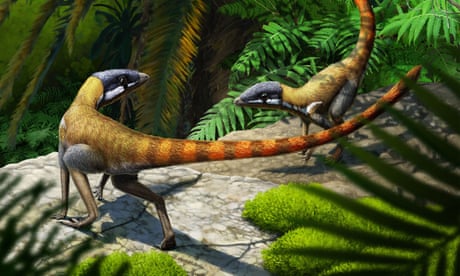After more than a century of debate, researchers have settled the mystery of a tiny, enigmatic reptile that left an impression on Scottish sandstone nearly a quarter of a billion years ago. The 20cm-long creature, Scleromochlus taylori, was discovered near Elgin in Moray in the early 1900s, but all that remained from a handful of specimens were the natural moulds created in the rock when the fossilised bones dissolved away. Without pieces of skeleton to mull over, palaeontologists resorted to filling the impressions with wax and latex to make casts of the bones.
From these they concluded that the reptile had a large head, a short neck, a slender body and long hind limbs. It lived about 240 to 210 million years ago. But where the creature sat in the tree of life proved a tougher puzzle to crack.
Some experts claimed the reptile was a close relative of the dinosaurs, but others argued it was a forerunner of the pterosaurs – the first animals with bones to take to the skies – ultimately with the wingspan of a Cessna plane. In the hope of finally resolving the mystery, researchers led by Davide Foffa at National Museums Scotland turned to computed tomography (CT) scans. The images revealed the creature in unprecedented detail, allowing scientists to reconstruct the entire skeleton and find its proper place in evolutionary history.
Writing in Nature , the researchers describe new features of the animal, such as the shape of the upper jaw and thigh bones, which show that it belonged to a group of Triassic reptiles known as lagerpetids, which are more closely related to pterosaurs than dinosaurs. The work suggests that the ancestors of the giant flying pterosaurs, commonly known as pterodactyls, were lithe little reptiles that scampered around on two legs, feasting on insects. “We have this image of giant pterosaurs as big as a plane, but the very early ones were no bigger than a coffee table,” Foffa said.
“They were much closer to the size of Scleromochlus. ” Prof Paul Barrett, a palaeontologist and co-author on the study at the Natural History Museum in London, said the reptile was hard to pin down because of its small size and poor preservation. The CT scans allowed the team to see tiny bones still encased in the rock and to digitally fill in the voids in the sandstone to create accurate virtual models of the animal.
The research may end the debate over Scleromochlus, but scientists are still unclear how small, ground-based reptiles evolved into soaring pterosaurs, albeit small ones, 10 to 15 million years later. There are no fossils preserved of reptiles that had taken steps towards an airborne life, but were not yet fully-fledged fliers. Sign up to First Edition Free daily newsletter Archie Bland and Nimo Omer take you through the top stories and what they mean, free every weekday morning Privacy Notice: Newsletters may contain info about charities, online ads, and content funded by outside parties.
For more information see our Privacy Policy . We use Google reCaptcha to protect our website and the Google Privacy Policy and Terms of Service apply. “When the pterosaurs first appear in the fossil record, they are already completely adapted for flying, they are already good fliers,” Foffa said.
“We do not have an animal that is in between lagerpetids and pterosaurs, which is frustrating, but I hope that at least we are providing some extra information on what these animals would look like. ”.
From: theguardian
URL: https://www.theguardian.com/science/2022/oct/05/scleromochlus-taylori-reptile-unearthed-scotland-related-pterosaurs



